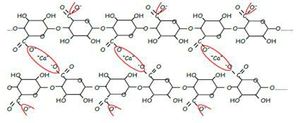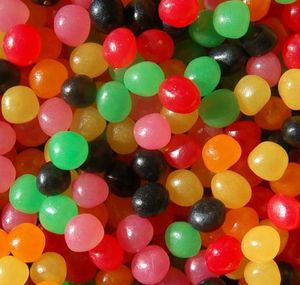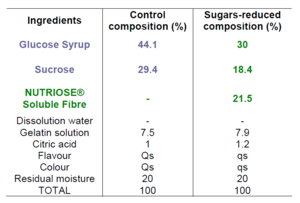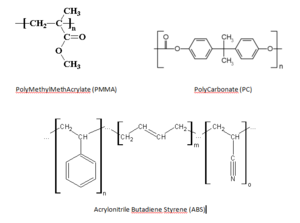Molecular Gastronomy
How to meet Food and Polymer?
One of the possible answers is the Molecular Gastronomy and I take an example that I love it : the precipitation of sodium alginate into calcium lactate with a liquid inside.
When you click on the following link, you will be able to see a video of the preparation of this molecular reaction
http://www.youtube.com/watch?v=OlJKpt74TvI&feature=fvwrel
Not to let you without any explanation, I am going to give you scientific details about what happens on this video.
First he prepares a aqueous calcium lactate solution from food calcium lactate powder and mixing that he adds to the lemon juice
Then he puts the mixture inside a silicon tin and he freezes the solution in order to solidify it under 0°C
In the meantime, he prepares the sodium alginate solution from food sodium alginate powder and strong mixing, which gives a viscous polymer solution
sodium alginate formula
Now he dips the cooled "bubbles" into the sodium alginate and that is the moment when the science works. Indeed thanks to Ca2+ which has 2 charges + the polymer which has only one charge + can react with Ca2+ in order to make a spherical tough covering
Finaly he rinses the bubbles and dips them into different food colorants. All the products used in this videa are safe!
Like that you can make funny little food bubbles for your party which can be made from other liquid like other fruit drink if only the pH stays above 4.
With these little bubbles you are sure to succeed among your friends!
And if you want to impress more your friends, look for any ideas on that link
http://www.moleculargastronomynetwork.com/additives.html
After fat: sugars reduction
Recently, consumers have been careful about their health and do some efforts each day and that in all countries in the world. To respond to the demand and to the recommendations of the WHO (World Health Organization), the food industries formulate products with less sugar and fat component. In a french study, it was shown that products with less sugars are most consumed because they are considered to be "good for health".
The french company Roquette have made some efforts to reduce sugar contents. In that case, a dietary fibre is used to keep its image to do some natural products and to substitute sugars and calories.
In a french survey in 2011 among 300 people, the primary consumer criteria for buying sweet products are taste then price and finally nutritional values. Moreover than 75% of consumers identified sweet food taste with pleasure. In this same survey,the sugars-reduced products are consumed by 75% of the sample. People eat as many sugars-reduced products as standard products. But they make a link between percent of sugar and the calories (reduced-in-sugar = less caloric).
In that fact, they create a new molecule: NUTRIOSE which take the sweet taste with less calories. This molecule give an optimal quality and test and at the same time, improve the nutritional profil of less-fat products. Moreover this ingredient is made of wheat or maize.
This molecule is so a good alternative for sugar and too much calories...
Ecobulle
For the last 12 months, I have been working with 5 other students on soap encapsulation. Our project consisted in creating soap balls to wash hands.
We started by thinking about the drawback of other types of soap. Indeed, soap blocks aren't very transportable and attract bacteria; and soap pumps causes a waste soap. After that, we interviewed a sample of 100 people and the conclusion was that people often lacked soap in public places
Our product solves all these problems because you can use the soap ball everywhere and you can keep it in your bag.
Today, we have created our soap ball with coextrusion method using sodium alginate which gelifies when in contact with calcium chloride and create a solid envelope. We met some problems like ball size which is too small and also, we also had difficulty centering the soap in the ball and can escape of the ball.
We were selected to continue our project to June to ameliorate our product and contact an industrial.
Where can we find polymer matter?
Polymer can be found everywhere, numerous appliances and daily-used objects are composed of polymers, so you handle polymers without even knowing it! For example, when you blend vegetables or fruits in your blender, you are in front of an object composed of polymers as you can see on the following picture
Indeed, PMMA (PolyMethylMethAcrylate) or PC (PolyCarbonate) is used for its transparency and its shock-resistance and ABS (Acrylonitrile Butadiene Styrene) is used to its resistance to shock too but moreover for its rigidity and its surface condition and you can find each formula below
If you want more details about the synthetis of these different polymers, you can click on the different links below
http://www.academicjournals.org/ajpac/pdf/pdf2010/August/Arora%20et%20al.pdf is refered to PMMA
http://www.eng.buffalo.edu/Courses/ce435/DVD/sld007.htm to PC
http://www.chemsystems.com/reports/search/docs/abstracts/93s8abs.pdf to ABS
Good Morning little scientist!
Hello,
My name is Benjamin, I am 21 and I come from a little town near Toulouse. Today I am a second year student of the graduate School of Chemistry, Biology and Physics in Bordeaux in the department of Chemistry and Physics. For my third year, I specialize in polymers.
Consequently in this blog, I am going to speak about Polymers in numerous applications and finally together we are going to make a link between the three scientific fields : Food, Quality&Security and Polymers.
To make your mouth water, first what is a polymer?
"Any of numerous natural and synthetic compounds of usually high molecular weight consisting of up to millions of repeated linked units, each a relatively light and simple molecule" by The American Heritage® Dictionary of the English Language, Fourth Edition copyright ©2000 by Houghton Mifflin Company.
If you are curious to know more about Polymers their aspect or their properties, see you soon for new articles.
Have a nice day!
Benjamin
Recycling e-waste ?
The world needs standards for the recycling of electronics like computers or televisions. That's why a program led by an alliance between private and public agencies, called StEP (Solve the E-waste Problem), has been established. Its mission is to provide rules and procedures for recycling e-waste.
This plan has recently been accused of uselessness because rich countries continue to dump their waste in poor countries. Evenf if it has many excellent aspects, there is a loophole in this convention which autorized people in rich countries to export their e-waste if it is to be recycled. But it is often ending up in rubbish dumps and contaminating groundwater.
Professor Markus Reuter, an Australian-based chemical engineer and StEP participant, has been trying to solve this problem. He is the chief executive of a company which has developped a technology to recycle e-waste.
To date, this technology isn't very used because it's cheaper to send e-waste in developing countries but StEP must continue on this path.
Mélanie
Hello everybody !
I'm Mélanie a Physics and Chemistry major. I'm 21 years old and I live in Bordeaux, France. I'm naturally curious and I spend a lot of time on the web to find the latest news in science. For this blog, I will focus on Quality, Security and Environment (QSE).
Currently, I study QSE at ENSCBP and from July to November I'm going to discover the business and industrial world during a work placement. APESA (the company name) helps other industrialists to set up Quality Control and Management systems in order to guarantee the employees safety.
I think this company has a promising future because ten years ago, QSE wasn't rooted in mentalities and these concerns were ignored. Today, QSE is everywhere and each domain of industry has to respect these rules to protect human people and environment. It's a real challenge to change habits.
I want to take part in this change, like you !
Welcome everyone!!
My name is Marine and I'm a food science major in Bordeaux, France. I'm 24 and I want to share my passion for food with you: new products or production techniques,advice on how to eat heathily or my favorite recipes. I'm fascinated by nutrition and the link between the food habits and some diseases like Alzheimer or Parkinson diseases.
So with this blog, I want you to discover the world of food industries with the good points but the dark side too.
Welcome !
Hi everybody !
First, thank you very much for being on this page.You won't be disappointed by your visit.
Here, you can find out all the latest discoveries in food science, polymers and quality/security concerns.
We are three students, with a passion for science, and we are going to try to share it with you.
Enjoy !














